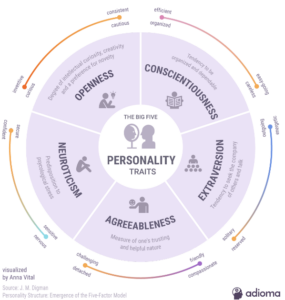I’ve always been very sure of who I am. I mean I’ve taken every personality test known to man. My Myers-Briggs type, ENFP, told me that I’m expressive and creative. The enneagram test categorized me as a type 7, making me optimistic and spontaneous (although some people may say I’m easily distracted). The Big 5 test told me I’m extremely extroverted and open to new experiences. These personality tests have made me aware of my strengths and weaknesses and helped me have more confidence in myself. However, when the COVID-19 pandemic hit, I felt drained and not like my normal outgoing and positive self. Some of my friends felt the same way and dreaded the thought of isolating again, but some felt more energized and loved the lockdown. Why was there such a difference?

There are multiple measures of personality including MBTI, enneagram, Hexaco, and the Big 5 test. Out of all of the personality tests, the Big 5 test is considered the most reliable and scientifically backed. Unlike many other personality tests, which ask unnecessarily complicated questions, Big 5 asks straightforward questions about easily quantifiable characteristics. For example, it might ask “how accurate is the following statement: I get chores done right away” (personally, I’ll go with a “Strongly Disagree” for that one). After an extensive series of questions, which takes someone as indecisive as me forever to complete, the test spits out how much of each trait the test taker exhibits. It measures five different traits: openness, conscientiousness, extroversion, agreeableness, and neuroticism. For the purpose of this blog, I’m going to focus solely on the extroversion trait.

Extroversion is a spectrum of how sociable an individual is, with extroverts falling higher up and introverts falling lower down on the scale. Contrary to popular belief, introverts aren’t necessarily quiet, they just recharge and feel more energized when they spend time by themselves. They need time alone to feel more energized since spending too much time in a social setting will drain them. Similarly, extroverts aren’t necessarily loud and the life of the party, although I’d still like to think that I am. The main characteristic of extroverts is that they feel recharged in public situations. They need more social interactions in order to feel refreshed and energized. When I took the Big 5 test, I scored very high on extroversion, which explains my sudden uptick in energy after I force myself out of my pjs and socialize.
However, when the COVID-19 pandemic hit, limited interactions became the norm. Many countries enforced a stay-at-home order with the intention of limiting physical interactions. As a result of this, many people were stuck at home alone (my nightmare) or with very little company. The main in-person social interactions were restricted to those in a household and all other interactions occurred over the phone or the internet. For the first few months, my family barely stepped foot outside our house other than to walk our dog, I only interacted with my friends over the phone or on a video call. Any interactions I would have with people at school were just completely lost. Even though I lived at home with my family, I still felt very cooped up and isolated because I couldn’t leave my house. If this seems like the perfect recipe for a sudden increase in mental health issues, that’s because it was. According to the World Health Organization, the rates of depression and anxiety went up 25% in one year.
Depression can be inherited genetically or developed through environmental stressors. When the body is under stress, the stress hormone, cortisol, is released, causing physiological effects, like elevated heart rate, that allows us to escape the stressor. After the stressor is gone, the body returns to normal. However, when there is consistent stress over a long period of time, the body’s “fight or flight” is constantly activated and there are always elevated levels of cortisol. This can lead to stunted neuronal growth in the hippocampus. According to Harvard Health, there is a connection between a smaller hippocampus and depression. COVID-19 introduced many stressors, such as the fear of you or your loved ones falling sick, deaths in the family, and having to adjust to living alone. Many people developed chronic stress, which led to depression.

In order to understand how the pandemic changed our personality, we first need to understand how personality can impact well-being. Well-being, how healthy and comfortable someone is, can be split into two categories, subjective and psychological. Subjective well-being measures positive affect (how much a person experiences positive emotions), negative affect (how much a person experiences negative emotions), and life satisfaction. Psychological well-being measures positive relationships, self-acceptance, independence, life purpose, environmental mastery, and personal growth. A metastudy done before the pandemic took a survey of self-reported personality and well-being status, then a proper test of personality using Hexaco (which is very similar to the Big 5 test), and finally a test to measure well-being. The result of these tests showed a high positive correlation between extroversion and well-being (sorry introverts <3), especially in positive affect, positive relations, and self-acceptance. There was also a negative correlation between extroversion and negative affect. This means extroverts in general have a better sense of well-being and are more prone to experience positive emotions compared to introverts.
After the pandemic, there were some apparent shifts in mental health. In addition to this, there was a shift in many people’s sense of well-being. A similar study of well-being was conducted during the coronavirus pandemic and found a significantly lower correlation between extroversion and well-being. Prior to the pandemic, there was a 0.44 correlation between extroversion and positive affect. There was also a -0.28 correlation between extroversion and negative affect. However, during the pandemic, the correlation between extroversion and positive affect was 0.31 and the correlation between extroversion and negative affect was -0.18. This decreased correlation makes sense since we know that extroverts feel energized when they’re in a social situation and the opportunities to socialize went down drastically with the rise of the pandemic.
As a result of the pandemic, people had fewer social interactions. Extroverts had an especially tricky time with this as they recharge in social situations. Prior to the pandemic, they were more likely to feel positive emotions than introverts. However, during the pandemic, although they were still more likely to experience positive emotions than introverts, it was far less than they would have prior to the pandemic. Now, with a majority of the restrictions lifted, I can confidently say that I’m back to smothering people with optimism and making new friends as fast as omicron spreads.
